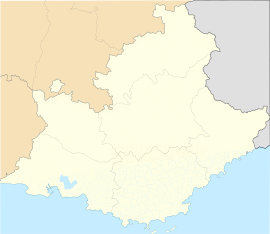Flayosc
Flayosc | |
|---|---|
 A view of the village from the road to Colle | |
 Coat of arms | |
show Location of Flayosc | |
 Flayosc | |
| Coordinates: 43°32′06″N 6°23′51″E / 43.535°N 6.3975°ECoordinates: 43°32′06″N 6°23′51″E / 43.535°N 6.3975°E | |
| Country | France |
| Region | Provence-Alpes-Côte d'Azur |
| Department | Var |
| Arrondissement | Draguignan |
| Canton | Flayosc |
| Intercommunality | CA Dracénie Provence Verdon |
| Government | |
| • Mayor (2020–2026) | Karine Alsters |
| Area 1 | 45.95 km2 (17.74 sq mi) |
| Population (Jan. 2018)[1] | 4,282 |
| • Density | 93/km2 (240/sq mi) |
| Time zone | UTC+01:00 (CET) |
| • Summer (DST) | UTC+02:00 (CEST) |
| INSEE/Postal code | 83058 /83780 |
| Elevation | 140–752 m (459–2,467 ft) (avg. 235 m or 771 ft) |
| 1 French Land Register data, which excludes lakes, ponds, glaciers > 1 km2 (0.386 sq mi or 247 acres) and river estuaries. | |
Flayosc (French pronunciation: [flajɔsk]; Provençal: Flaiòsc) is a commune in the Var department in the Provence-Alpes-Côte d'Azur region, in southeastern France.
Geography[]
Flayosc is far 7 km (4.3 mi) from Draguignan, and about 35 km (22 mi) from the Mediterranean Sea.
The village is located on a rocky hill, near the church. Three very small rivers crosses the village : the Pontchalade, the Florieyes and the Rimalte.
History[]
Antiquity[]
The place allowed local residents to watch over the valley and to protect villages in the neighbourhood, for example Saint-Lambert (far from 5 km).
After the destruction of Antea, a village in the neighbourhood, by the Roman Empire, people decided to live in this place.
Since 1789[]
The lord of Flayosc lost his powers and his castle during the French Revolution.
In the 19th century, the village became a place where shoes were made : many factories were created. The village had, thanks to this activity, a long prosperous period. About 3,000 people lived in Flayosc in 1914.
Natural patrimony, fauna and flora[]
The village is classified in Zone Natura 2000 and in Zone Naturelle d'Intérêt Ecologique, Faunistique et Floristique.
Twin towns[]
 Vezza d'Oglio since 2002
Vezza d'Oglio since 2002
Bibliography[]
- Charles-Laurent Salch, Dictionnaire des châteaux et fortifications de la France au Moyen Âge, ed. Publitotal, reprint 1991, page 478.
See also[]
- Communes of the Var department
- Draguignan
References[]
- ^ "Populations légales 2018". INSEE. 28 December 2020.
External links[]
- (in French) Statistics
- (in French) Local council of Flayosc
- (in French) Map of Flayosc
- (in French) Architectural patrimony on the site of French Ministry of culture
- (in French) Protected patrimony of Flayosc
- (in French) Site of the regional Office of Ecology
| Wikimedia Commons has media related to Flayosc. |
- Communes of Var (department)
- French Riviera
- Var (department) geography stubs


